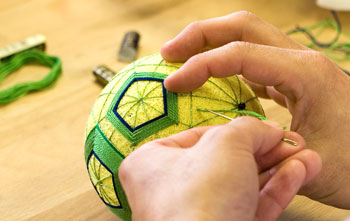Using Stitched Pins with Patterned Fabric...When selecting patterns, consider that a pin or brooch should be
no larger than 2 inches diameter. A good tool to help select the scale
of the pattern is your thumb and fore or middle finger. If the total
pattern fits inside, it’s a good candidate for your project.
For
stitching, I used single strands of silk or 6-strand floss together with
machine embroidery metallics in a full spectrum of colors. Often the
fabric patterns can be left to show through and provide another dimension
for the design. Add a little couching for distinction. Use a metallic
cord and thin machine embroidery to tack it down.

Use contours of the pattern to determine direction of stitches. Keep
all stitches within a color area parallel (all the same direction).
Change stitching direction in adjacent areas when thread colors change.
Stitch from Background to Foreground.
Lay in the colors in back
first. Frequently a simple running stitch can be used for the background
with a very minimal amount running under the surface. Staggered, uneven
lengths of stitches in long parallel line can cover quickly and
effectively.
Sometimes outlining the border of the shape helps to clarify the
boundary. Use stem stitch to outline. Then stitch directionally across
the shape and over the outline. It’s a nice finished line. Save contrast
and highlights or dark shading till the end.
If you have some neat rubber stamps, try them on plain colored
fabric; monogram your initials; make hearts or stars for your charity’s
donors, or special badges for your stitchery group. Beads and dangles
can add further distinction.
Till next time,

Why Do We Make Temari?
For the sheer pleasure and joy of it. It is at the same time calming and compelling. Temari patterns
develop in ways that are surprising and unexpected, often the inverse of what is assumed. Temari
expands thinking skills.
Like yoga for the mind, it gently exercises, reaching beyond for more flexibility. It extends your thinking processes beyond what is apparent, known and
obvious. But it is utterly logical and completely organized. It is the kind of knowledge that provokes new ideas and different solutions to every day
questions and problems of all kinds. It is “thinking outside the box.”
As a design process, it gives an open invitation to play with colors in proportions and combinations that are unusual. It stimulates new or innovative
combinations of colors because it is non-pictorial. It lures the designer to move into new areas,
unencumbered by Western culture’s symbolic colors, i.e., blue for sky, green for plants, red for flowers, because most temari patterns are symbolic not
pictorial. So, experimentation with color is completely open-ended.
Temari’s measuring technique is like nothing in Western culture. Yet its methods are so simple! We wonder why there is nothing like it any where in the world. Like reading a good book, temari compels you to keep going just to see what happens! Like a
light bulb in your mind, it constantly surprises and delights.
Till next time,

